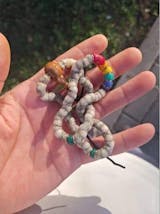These beautiful vajra were handmade by Tibetan craftsmen from Tibet in 1990's,from Hepo Town, Baiyu County, the birthplace of the famous Tibetan handicrafts.
It is nine-pronged vajra,made of cold iron,3.5 inches length.
You can make it a necklace, pendant, keychain, mala pendant, or put in your shrine.
In tantric Buddhist practice, the vajra is a potent instrument with multifaceted meaning, symbolizing the adamantine state of existence of a Buddhist practitioner who has reached full enlightenment. The vajra is the archetypal symbol of tantric Buddhism.
Details:
Material: cold iron,copper
Production Process: hand forging
Size:
Height:86mm /3.5 inches
Diameter:12mm / 0.47 inches
ABOUT VAJRA
Vajra is a Sanskrit word meaning both thunderbolt and diamond. It is a weapon which is used as a ritual object to symbolize both the properties of a diamond (indestructibility) and a thunderbolt (irresistible force). The five-pronged vajra is the most commonly seen vajra.
This Vajra is to be used during empowerments. Usually needs two Vajras, one for the Mandala which is tied to the Sung-Tak with five colored cord and the second one for the Vajra Master. Sanskrit word vajra or Dorje in tibetan is defined as "diamond" or "adamantine". As such, the word vajra sometimes signifies enlightenment, or the absolute reality of shunyata, emptiness. Dorje offers protection and envokes blessings.
An instrument symbolizing vajra is also extensively used in the rituals of the tantra. It consists of a spherical central section, with two symmetrical sets of five prongs, which arc out from lotus blooms on either side of the sphere and come to a point at two points equidistant from the centre, thus giving it the appearance of a "diamond sceptre", which is how the term is sometimes translated.
Vajra
The vajra is made up of several parts. In the center is a sphere which represents Sunyata,the primordial nature of the universe, the underlying unity of all things. Emerging from the sphere are two eight petaled lotus flowers.One represents the phenomenal world (or in Buddhist terms Samsara), the other represents the noumenal world (Nirvana). This is one of the fundamental dichotomies which are perceived by the unenlightened. The physical manifestation of the vajra, also called dorje in this context, is the male organ.
Arranged equally around the mouth of the lotus are two, four, or eight creatures which are called makara. These are mythological half-fish, half-crocodile creatures made up of two or more imals, often representing the union of opposites, (or a harmonisation of qualities that transcend our usual experience). From the mouths of the makara come tongues which come together in a point.
The five-pronged vajra (with four makara, plus a central prong) is the most commonly seen vajra. There is an elaborate system of correspondences between the five elements of the noumenal side of the vajra, and the phenomenal side. One important correspondence is between the five "poisons" with the five wisdoms. The five poisons are the mental states that obscure the original purity of a being's mind, while the five wisdoms are the five most important aspects of the enlightened mind. Each of the five wisdoms is also associated with a Buddha figure. (see also Five Wisdom Buddhas)
ABOUT Thokcha -Thunder Iron
Thokcha (Tibetan: ཐོག་ལྕགས, གནམ་ལྕགས) are tektites and meteorites which serve as amulets.Typically high in iron content, also called Thunder Iron,Cold Iron.These are traditionally believed to contain a magical, protective power comparable to Tibetan dzi beads. Most thokcha are made of a copper alloy.
Thogchags or Thokcha are worn as amulets by Tibetans, specifically people of the Himalayan regions, for spiritual protection and healing. Created in several forms, they often depict tantric deities, sacred animals, auspicious symbols, and mantras. Many represent ritual supports such as a mirror, phurba, or vajra. Some pieces may be abstract in nature, and the meaning of the form has since been lost in antiquity. Further research is still in the process. Other Thokcha were simply used as ancient arrow points, buckles, body armour, or even old horse trappings.
ABOUT US
We're artisans from Hepo Township, Baiyu County,Tibetan.
We use ancient Tibetan handicrafts to make Tibetan Buddhist instruments.
All our crafts are directly handmade from Tibet.
When you purchase this craft it helps and support our artisan and our families in Tibet.
Your support is highly appreciated.
Packaging &Shipping:
As per our Product nature, we do the packaging. For every single product, we do the bubble wrapping along with the paper carton boxes is also used for more safety. In the case of heavy products, we also use wooden boxes too for more safe packaging and sent for the shipping process.
Feedback:
Our goal is to make sure my customer is happy and satisfied when you shopping with us. Please contact or email before leaving negative feedback.
We will try out best to solve our issues. Please give us the chance to resolve any problem.
Notice:
1.Please allow 1-2mm error due to manual measurement.
2.The color may have different as the difference display.
3.Please make sure you do not mind before you bid.
THANK YOU FOR purchasing our product.






















































